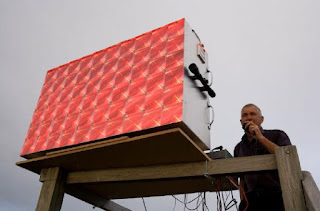 Lightwave Madness
Lightwave Madness
 |
| The 288 km path courtesy: REAST |
One of the local lightwave builders, Mark (VA7MM), brought my attention to some outstanding lightwave work conducted several years ago, by a group of very dedicated amateurs in Tasmania.
A pair of articles describes their successful attempts to send signals, via cloudbounce, over the astounding distance of 288km (180mi), crossing Bass Strait between the north Tasmanian coast and southern Australia.
What did it take to transmit lightwave signals over such a distance? Basically a system similar to the ones recently employed in our own local lightwave experiments but on a grander scale ... much grander!
The receiver is based on one of the KA7OEI designs, with modifications to increase its sensitivity. The receiver, and several other designs, can be found on Clint's website here, probably the best source of information on amateur lightwave available anywhere.
 |
| The lightwave receiver courtesy: REAST |
 |
| The 10mm x 10mm rx APD courtesy: Hamamatsu |
The transmitter was also big, consisting of an array of 60 red Luxeon III LED's, similar to the Red Rebel Luxeons used in our own local tests. Each LED had its own 12cm square fresnel lens, heatsink and method of focusing. Certainly this was a mammoth project, by amateur lightwave standards.
 |
| The 60 LED TX array courtesy: REAST |
Earlier long-haul tests out to 209 km used the digital JT65 mode for signal decodes but the 288 km test used a fairly esoteric weak signal mode called WSC built on the Spectrum Lab software. This mode is capable of digging almost 20 db deeper into the noise than JT65, down to almost -50db.
An in depth description of the two long-haul events, including equipment schematics, can be found in "288 km Cloudbounce from Tasmania to the Australian Mainland" and in "209 km with Narrow Beamwidth Transmitter".
The 288 km crossing project evolved over several years and is all very well documented, from the first early steps, at the Radio and Electronics Association of Southern Tasmania's (REAST) website here.
This adventuresome project was largely the work of VK7MO, VK7JG, VK3HZ and VK7TW. Their work is most inspiring and much can be learned from seeing what they discovered when transmitting into the cloudy nighttime skies.
Such an endeavour as this makes the local, much shorter Georgia Strait crossing, seem like a cake-walk, but I can't imagine using anything that big and bright here without causing trouble ... it would probably appear much too 'laser-like' to talk one's way out of a jam. Pointing anything resembling a laser light into the air these days is simply begging for trouble.
I can however, envision a scaled-down version, perhaps consisting of an array of four Luxeons ... at least on my end of the path, but even pointing one of those from the city could be problematic. Perhaps any NLOS lightwave attempts across Georgia Strait will need to be well away from Vancouver and its two-million sets of eyes.














I think anything other than a 5mW laser in VK needs a licence. They are classified as a dangerous weapon. I had to give my 30 mW laser to the local police as I didn’t want to get a dangerous weapons licence. I used it as a telescope pointer and to point out “things out there”
John, I’m surprised you would find this laughable. In this day and age of heightened awareness, pointing ANY bright light into the sky around a major city (ie. lots of aircraft activity) is a quick way to garner unwanted attention. Here in Canada, it is strictly regulated. I definitely stand by my statement.
GOOD DAY ALL,
Well I wonder something ; what are you using as the Receiving antenna ?
Photo Diodes ?
I have just made a tremendous leap forward in signal strength.
I found that if one uses a Solar Electric Panel in conjunction with
a magnetic unun coil that HUGE signal gain happens and I mean HUGE.
NO need for ANY lenses of ANY kind.
I am very close to actually having a send & receive signal ratio that is equal to
or greater than the Ratio using the electron field.
Fellow hams I have found that VOLTAGE VOLTAGE VOLTAGE is the prime factor.
Of course quiescent current is all that is needed .
I am able to operate in any mode.
Well there you are and here I am ,
Hope to hear your feedback,
Dan WD8PCU Photon Communications Unit
73
Greetings everyone,
Just a note to say that I am getting awesome results using this setup :
I use a 100 watt All Mode Transmitter that modulates a large 100 L.E.D. Cluster .
Infrared ,
The Receiver is GREAT as it is a Hewlett Packard HP – 312 B ; Frequency Selective Voltmeter. I can hear signals down in the PicoVolt level.
I can run SSB extremely good with excellent results.
I use a very big 72 Cell Solar Panel Array as the Receiving Antenna MINUS the rectifier diodes & feed the Panel via coax directly into the RF Input Jack on the HP -312 B.
I also run a 40 watt PA audio amplifier @ the audio out port jack to drive a speaker. The HP-312B has USB & LSB capability .
You will be stunned @ how excellent the performance is.
Contact Dan @ my email anytime for more details wd8pcu@cox.net